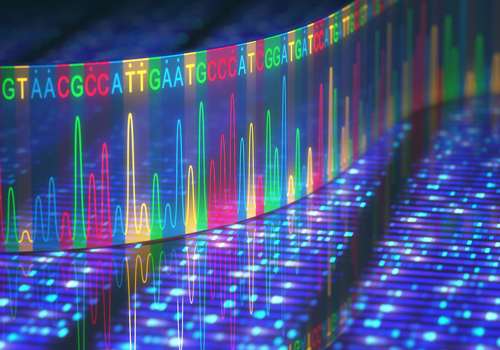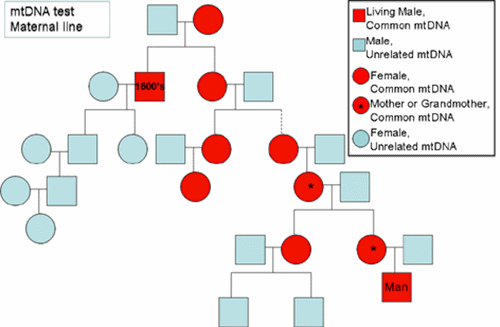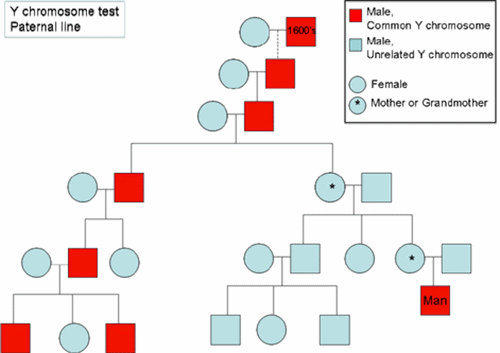
How can a living male determine whether he is a descendant of a male who lived in the 1600s?
October 30, 2009

- Related Topics:
- Y chromosome,
- Genetic genealogy,
- Mitochondria,
- Relatedness,
- Ancestry
A curious adult from California asks:
"If a living male [age 40 yrs] wants to determine whether he is in fact a true descendant of a male who lived in the 1600s, how could this be done? Can tests be done? What tests? Facts: The mother of the living male is his connection to the 1600s ancestor. The mother’s connection is through her own mother [1904-1962]. If needed, the living male can contact confirmed descendants of the 1600s progenitor."
There are definitely tests that'll tell this man if he is related to the guy from the 1600's. But these tests can't tell him if he is directly related. They can only tell him if he shares a common ancestor with people who know for sure they are direct descendants.
These tests are genetic ones -- they would compare his DNA to descendants of the ancestor. If they match, then he may be related. If they don't, then he may not be.
Even if the test shows his DNA doesn't match a known descendant's, he could still be related. This is because the tests that go back that far are pretty limited.
In fact, in this case he can't directly compare his DNA to just any living descendant. He'll need a good family tree to figure out who he should be comparing his DNA to.
This is because the ancestor he is interested in is a male. And he is related to him through his mother.
To see why this makes things a little tricky, we'll need to go over the science behind these genetic tests. Then we'll see how to use these tests in combination with a family tree to figure out if the living male could be related to the man from the 1600's.

Ancestry Tests Look at Small Differences in our DNA
DNA is made of four molecules known as A, C, T, and G. Humans have 6 billion of these molecules all arranged like a bunch of letters strung together. The order of these letters makes each of us who we are. Much like a code or recipe for life.
Even though all of us are unique, 99.5% of our DNA is the same! And we pass our unique differences down to our kids. Who passes them down to their kids. And so on.
Scientists focus on a few of these differences to help determine our ancestry. These differences are known as genetic markers.
In theory, if you and another person share many of these genetic markers, then the two of you are related. If only it were so easy!
After about five generations, most DNA becomes impossible to follow because of something called recombination. This is a process where parts of our DNA start shuffling pieces with each other. (Click here to learn more about recombination in DNA testing.)
Lucky for us there are two kinds of DNA that don't recombine very much -- the Y chromosome and the mitochondrial DNA (mtDNA). We can use these DNAs to trace our ancestors back thousands of years. But only in a limited way.

The mtDNA Test Only Traces Maternal Lines
Almost all of our DNA is kept in a special part of the cell called a nucleus. The exception to this is mitochondrial DNA (mtDNA).
Mitochondrial DNA is found in compartments inside our cells called mitochondria. These are the powerhouses of our cells, where energy is made. (Click here for why mitochondria have their own DNA.)
When a sperm fertilizes an egg, nuclear DNA from both parents mix together in the egg. However, mtDNA from the sperm cell doesn't enter the egg and is lost. This means the egg has the nuclear DNA from both parents but only the mother's mtDNA. Therefore only the mother's mtDNA is passed down to the next generation.
Because the mtDNA is always passed on from mother to child, the mtDNA test can only trace your mother's line of ancestry. The man trying to figure out his ancestry happens to be connected to the ancestor through his maternal line. His mtDNA should be almost identical to his mother's and grandmother's.
However, he wants to trace his ancestry back to a male from the 1600's. Any children that ancestor had would not have his mtDNA -- they would have their mother's.
But all hope isn't lost! This is where a good family tree can help.
As we said, any of the ancestor's kids won't have his mtDNA. But his sisters' kids will. So will any female relative of the ancestor's mom like her sisters. Any direct descendant along the female line from the 1600's man's sisters or mother can be used in the test.
This can be a bit confusing so I've made this hypothetical family tree to hopefully make it all clearer. In this tree, the circles represent females and the squares males. The red shapes are the people who share mtDNA with the living male and the male from the 1600's. In this case I am showing how to go back through the 1600's man's sister to the living male.

This sort of thing will work for any other female relative from the male ancestor's mother. The ancestor's aunts and all of their female kids will have the same mtDNA. And they'll be able to give it to their daughters.
So if there is a confirmed female descendant of the 1600's ancestor, her children should have her identical mtDNA. And the living male can compare genetic markers from his mtDNA to hers. If they match, then the two may be related.
The Y Chromosome Test Only Traces Paternal Lines
You probably remember that females have two X chromosomes and males have an X and a Y. The Y chromosome test looks at this sex-determining chromosome. Because the Y chromosome is passed down from male to male, this test can only tell you about your father's line of ancestry.
Using the Y chromosome test in this case is a bit like the mtDNA one -- it requires an indirect path. This is because the living male received his Y chromosome from his father. And we know the living male is related to the ancestor through his mother and grandmother, and not his father.
Again, this is where a good family tree comes in handy. Say the deceased grandmother still had a living brother (the living male's granduncle). Or that this brother had a son who is still living. Or even a grandson.
You might be able to use the Y chromosome test to compare their DNA with that of a male confirmed descendant. If they are related, they might share a significant amount of DNA. (Click here to read more about relatedness) This might result in a match if the male confirmed descendant's connection to the ancestor is through a paternal line. (Son-father-grandfather, etc. all the way back to the 1600's!)
I've again created a hypothetical family tree to help make this clearer. This tree is the same as the previous one except that the red shapes represent common Y chromosomes and not mtDNA.

I think you're probably beginning to see how hard this is! And why it's important to have a good family tree.
As you lose the line going back in time, you may be able to find it again through a distant great, great grand uncle or aunt and then keep going back. In other words, you may need to head down another branch of the family tree to pick up the trail again.
As you can also tell, the mtDNA and Y-tests are somewhat limited in that they can only trace the female on your mother's side or the males on the father's side. So hopefully some of the confirmed descendants will fall into the right gender and parental line.
The Mechanics of Testing
There are many companies out there that offer DNA testing. Most likely, you will swab your cheek cells or spit into a tube and send it in. The company can isolate your DNA then analyze your genetic markers. If you can get a confirmed descendant to also participate, then these genetic markers can be compared to determine if you had a common ancestor.
More Information on DNA Differences Between People
Where did the small differences that make each of us unique come from? Mostly from rare DNA changes that have built up over many hundreds or thousands of generations.
Sometimes a change is introduced when our cells make a mistake when copying their DNA. Other times, things from the environment can cause changes in our DNA. In both cases, if the damage isn't fixed, then the DNA is changed.
These random changes, or 'mutations,' can then be passed down from generation to generation. They serve as good genetic markers because they are rare and will only be in people descended from the person with the original change.
One type of difference scientists look at is called single nucleotide polymorphisms or SNPs. These are changes in single letters in a DNA sequence. For example, GATTACA can become GATTCCA.
Another difference is something called short tandem repeats, or STRs. Like the name suggests, these are short stretches of DNA that start repeating themselves. The sequence GATTACATACA in one person may become GATTACATACATACATACA in another person. The TACA sequence is repeated twice in the first person, whereas it is repeated four times in the second person.
SNPs and STRs are the two genetic markers used in genealogy tests.

Author: Gwen Liu
When this answer was published in 2009, Gwen was a Ph.D. candidate in the Department of Microbiology & Immunology, studying the structure and function of microrna genes in Chang-Zhen Chen's laboratory. Gwen wrote this answer while participating in the Stanford at The Tech program.
 Skip Navigation
Skip Navigation
